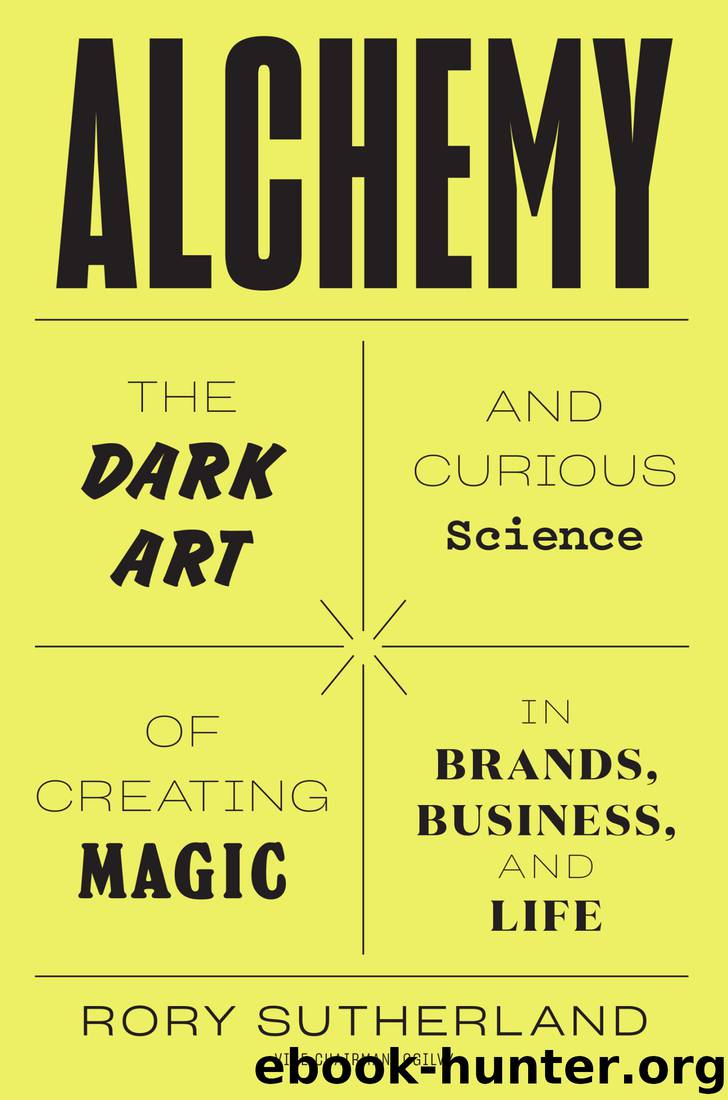Alchemy: The Dark Art and Curious Science of Creating Magic in Brands, Business, and Life by Rory Sutherland

Author:Rory Sutherland
Language: eng
Format: epub
Publisher: HarperCollins
Published: 2019-03-21T00:00:00+00:00
3.8: Bees Do It
When signalling their enthusiasm for a potential nesting site, bees waggle about in an exponential relationship to its quality; the amount of energy they expend in the signalling of a potential nest site is proportional to their enthusiasm for it. But they also make use of expensive ‘advertising’, in order to decide where to devote their time and attention.
The advertisements which bees find useful are flowers – and if you think about it, a flower is simply a weed with an advertising budget.
Flowers spend a great deal of their resources convincing customers that they are worth visiting. Their target audience is bees, or other insects, birds or animals that may help to pollinate the flower – a process that dates back at least to the time of the dinosaurs.* For the pollination process to be effective, the flower needs to convince the customers of its worth. To borrow the language of the Michelin Guide, a flower can be ‘vaut l’étape’, ‘vaut le détour’ or ‘vaut le voyage’; ‘worth stopping at’, ‘worth going out of your way for’ or ‘a destination in itself’. To do this, the flower places a costly bet, offering a generous source of nectar that rewards bees for their visit, and encourages them to stay at the flower for long enough to collect pollen on their bodies for dispersal elsewhere. But this nectar is kept out of sight – how can the flower, at a distance, convince the bee of the existence of a reward which it cannot verify until it has already exerted time and effort?*
The answer is that they use ‘advertising and branding’ – they produce distinctive, hard-to-copy scents and large, brightly coloured petals. These are noticeable, but producing them is risky, as they may attract the attention of herbivores that might eat them. The distinctive scent and petals act as a reliable (though not infallible) proxy for the presence of nectar, which a bee can use to help decide whether the visit is worth it or not.
A plant which has sufficient resources to produce petals and scent is clearly healthy enough to produce nectar, but using its resources for distinctive display will only really pay off if bees visit more than once, or if they encourage other bees to join them – there is no point in advertising heavily up front if you only make one sale. When you come here, the display says, I’m betting that you’re going to come back, or all my effort will have been wasted.
The system of information-sharing between the two species is also reliable – there is often a correlation between the size of petals and the supply of nectar. This saves a lot of wasted visits, because it means that a bee can tell from some distance away whether a plant is ‘a destination in itself’. It also requires that the plant use their resources on being distinctive as well as noticeable. If any type of flower is a better source of nectar, this
Download
This site does not store any files on its server. We only index and link to content provided by other sites. Please contact the content providers to delete copyright contents if any and email us, we'll remove relevant links or contents immediately.
| Direct | Global |
| Industrial | Multilevel |
| Product Management | Research |
| Telemarketing | Web Marketing |
Influence: The Psychology of Persuasion by Robert B. Cialdini(4715)
The Miracle Morning by Hal Elrod(4636)
The Hacking of the American Mind by Robert H. Lustig(4318)
Pre-Suasion: A Revolutionary Way to Influence and Persuade by Robert Cialdini(4142)
Unlabel: Selling You Without Selling Out by Marc Ecko(3587)
Ogilvy on Advertising by David Ogilvy(3503)
Hidden Persuasion: 33 psychological influence techniques in advertising by Marc Andrews & Matthijs van Leeuwen & Rick van Baaren(3472)
Purple Cow by Seth Godin(3137)
Who Can You Trust? by Rachel Botsman(3086)
Kick Ass in College: Highest Rated "How to Study in College" Book | 77 Ninja Study Skills Tips and Career Strategies | Motivational for College Students: A Guerrilla Guide to College Success by Fox Gunnar(3070)
The Marketing Plan Handbook: Develop Big-Picture Marketing Plans for Pennies on the Dollar by Robert W. Bly(2975)
This Is Marketing by Seth Godin(2969)
I Live in the Future & Here's How It Works by Nick Bilton(2933)
The Power of Broke by Daymond John(2895)
Building a StoryBrand by Donald Miller(2838)
The Tipping Point by Malcolm Gladwell(2822)
The 46 Rules of Genius: An Innovator's Guide to Creativity (Voices That Matter) by Marty Neumeier(2796)
Draw to Win: A Crash Course on How to Lead, Sell, and Innovate With Your Visual Mind by Dan Roam(2732)
Market Wizards by Jack D. Schwager(2643)
